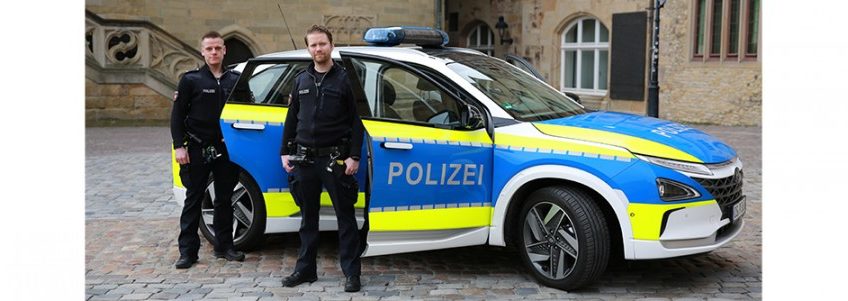A hydrogen patrol car with 100 percent fuel cell technology is now in use in Osnabrück. Besides Berlin, this makes it one of the first police departments in Germany to do so. With its alternative drive technology, the vehicle, which is completely free of locally produced CO2 emissions, will be tested for its suitability for everyday use in emergency and patrol services for one year.
This project of the Osnabrück Police Department is funded by the Federal Ministry of Transport and Digital Infrastructure (Bundesministerium für Verkehr und digitale Infrastruktur) as part of the National Innovation Programme Hydrogen and Fuel Cell Technology, with total funding of 20,460 euros. The funding guideline is coordinated by NOW GmbH and implemented by the Projektträger Jülich (PtJ) project management organisation.
The benefits of this noiseless patrol car with its new drive technology include: Zero CO2 emissions. In addition, the range is tremendous, refuelling is accomplished within a matter of minutes and, what’s more, the fuel hardly weighs a thing. The fact that the car is emission-free benefits cities in particular, which are especially affected by high levels of pollution. A suitable hydrogen filling station is located in Hasbergen-Gaste, directly on the outskirts of Osnabrück. The immediate proximity of the filling station to the place of operation in combination with the fast refuelling time guarantees high availability of the new police vehicle. Other officials who have already tested the patrol car are also impressed by the department’s new response vehicle.
The noiseless patrol car boasts a total range of about 666 kilometres (according to WLTP – Worldwide harmonized Light vehicles Test Procedure) on a single tank of fuel. Refuelling takes approximately 3-5 minutes. The vehicle accelerates from 0 to 100 km/h in 9.5 seconds and has a performance of 163 HP. The maximum torque is rated at 395 Nm. According to the manufacturer, consumption is stated as being 0.84 kg H2/100 kilometres. The unladen (tare) vehicle weight is 1889 kilograms. The Hyundai was converted from a normal car to a police patrol car in the first quarter of the year. In addition to the installation of flashing blue lights, siren and radio technology, this also involved its optical transformation into a recognisable, typical police vehicle.
From the Teutoburg Forest to the East Frisian Islands, in terms of electric mobility, the fleet of the Osnabrück police department already boasts 20 electric cars, 12 pedelecs and three electric motorcycles in the field of electric mobility. An additional highlight: Since 19 December 2019, the police have also been in action on the island of Juist with an electric quad bike. The idea for the E-Quad also originated at the Osnabrück police department, where it was conceived and converted. The deployment of a quiet vehicle like the quad on an island does not disturb animals or holidaymakers. This was already confirmed by the experiences with the electric police motorcycle on the island of Borkum, which has been used there successfully since 2017. Another 15 electric vehicles are currently being procured. Now, with the procurement of a fuel cell vehicle for deployment in the area of police operations, a further central component is being added to make the police department’s fleet more climate-friendly and to reduce CO2 emissions in a sustainable manner.


